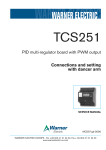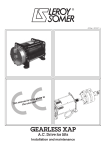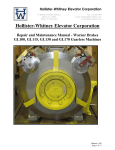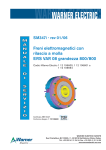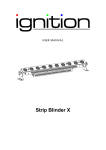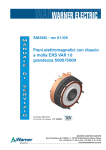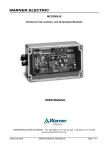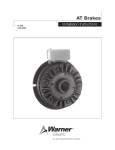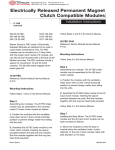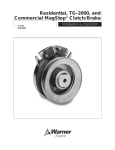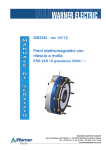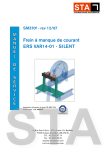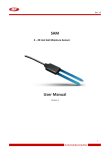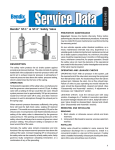Download Electrically Released Brakes ERS VAR10 SZ 5000/5000
Transcript
SM366gb - rev 01/06 S E R V I C E Electrically Released Brakes ERS VAR10 SZ 5000/5000 M A N U A L EC type certificate ABV 604/1 according drawing 1 12 106602 WARNER ELECTRIC EUROPE Rue Champfleur, B.P. 20095, F- 49182 St Barthélemy d’Anjou Cedex Tél. +33 (0)2 41 21 24 24, Fax + 33 (0)2 41 21 24 00 www.warnerelectric-eu.com We: WARNER ELECTRIC EUROPE, 7, rue Champfleur, B.P. 11095, F-49182 St Barthélemy d’Anjou Cedex declare that the brakes made in our factories from St Barthélemy d’Anjou, and hereafter designated: ERS VAR10 SZ 5000/5000 Fully comply with directive 95/16/EC on Lifts and are intended for incorporation into an installation or for assembly with other equipment, with the aim of constituting a machine subject to the application of directive 98/37/EC and the directive on Electromagnetic Compatibility 89/336 (modified). Compliance with the basic requirements of the Low Voltage Directive 73/23 (modified) is guaranteed by our full compliance with the following standards: NFC 79300 and VDE 0580/8.65. Drawn up in St Barthélemy d’Anjou, July 2002 E. PRAT, General Managing Director CONTENTS 1 2 2.1 2.2 3 3.1 3.2 3.3 4 Technical specifications Precautions and restrictions on use Restrictions on use Precautions and safety measures Installation Transport - storage Handling Installation Maintenance 1 Technical specifications 2 3 3 3 3 3 3 3-4 4 4.1 4.2 5 5.1 5.2 6 7 8 Intermediate flange Adjusting the airgap Adjusting the microswitch Electrical connection Important recommendations Connector Spare parts Tools Troubleshooting 4 4 4 4 5 5 5 6 Dust cover (option) Thread M16 (2 x 180°) O-rings Hub Magnet Friction discs heel on customer’s flange side Transport screws Dust cover (option) Fig. 1 Table 1 Nominal holding torque Maximum speed Nominal airgap Maximum airgap after wear OEX voltage Holding voltage Resistance Power (OEX) Power (holding) Cyclic duration factor Weight Thread M10 Fig. 2 Nm min-1 mm mm VDC VDC Ω Watt Watt ED kg 48 24 - ERS VAR10 SZ 5000/5000 5200 120 0,5 ±0,1 0,8 103,5 52 50 % 124 WARNER ELECTRIC EUROPE - Rue Champfleur, B.P. 20095, F - 49182 St Barthélemy d’Anjou Cedex 207 103,5 101 428 107 SM366gb - rev 01/06 2/6 Symbol designating an action that might damage the brake Symbol designating an action that might be dangerous to human safety Symbol designating an electrical action that might be dangerous to human safety 2 Precautions and restrictions on use 3 Installation 2.1 Restrictions on use 3.1 Transport / storage For the brake to comply with directive 95 / 16 / EC, the integrator must observe the general conditions for installations and use as defi ned in the EC type certificate ref. ABV 604/1 of 12th Feb. 2003 drawn up by the TUV Munich, including the mandatory use of a speed limiting device, in compliance with EN 81-1 paragraph 9.9 subpoint 9.10.10. This brake is delivered in standard packaging that will keep it intact for a period of 6 months during ground, air or sea transport towards neighbouring continents (without crossing the tropics). 3.2 Avoid any impact to the brake so that its performance is not impaired. This brake is designed to work in dry conditions. Friction faces must be kept completely clean of any oil, grease or abrasive dust. When handling, use the handling holes (M16 and M12) intended for this purpose (See Fig. 2). If maximum rotation speeds are exceeded, the guarantee is no longer valid. This brake may only be used in a “horizontal axis”. The customer must be careful not to alter the factory-set airgap, this is in order to ensure the brakes may be properly released. This brake is designed for a maximum ambient temperature of 40°C (coating class 155°C). The maximum temperature in continual use is 100°C. This brake is designed for static applications. Any dynamic braking is restricted to emergency braking and test braking. This brake can in no way replace the safety braking system used during lift descent. 2.2 Handling Never lift the brake by its cables. 3.3 Installation The brake is delivered pre-assembled with pre-set microswitches and airgaps. Fixing screws, the hub and the O-rings are supplied separately. Specifications for the customer‘s friction face : Material: Steel (150 to 250 HV) or cast iron Roughness ≤ Ra 3,2 Protection : Phosphatizing (dry) or nitriding Geometric tolerances : 0,1 0,1 Precautions and safety measures During maintenance, make sure that the mechanism to be braked by the brake, is stopped and that there is no risk of it accidentally starting up. All intervention have to be made by qualified personnel, owning this manual. Customer's shaft axis • Tighten the 3 transport screws CHc M10 • Put the hub into position on the customer’s shaft • Put the shock absorbing O-rings onto the hub (see Fig.1) Any modification made to the brake without the express authorisation of a representative of Warner Electric, in the same way than any use out of the contractual specifications accepted by "Warner Electric", will result in the warranty being invalidated and Warner Electric will no longer be liable in any way with regard to conformity. When switching on DC-side the coil must be protected against voltage peaks. • Engage the front disc on the hub, heel on the flange side (see Fig.1) Caution: When installing and should the brake ever be taken apart, make sure that the friction disc heel is the right way round when the brake is put back together (see Fig.1). • Engage the brake • Engage the rear disc on the hub, heel on the flange side (see Fig.1) WARNER ELECTRIC EUROPE - Rue Champfleur, B.P. 20095, F - 49182 St Barthélemy d’Anjou Cedex SM366gb - rev 01/06 3/6 • Finish putting the brake into position Check that it functions correctly by a few successive draws and releases. • Tighten the 8 fixing screws CHc M12(Cs: 130 Nm ±10%) (star sequence tightening, to an initial torque of 50 Nm) Microswitch adjusting screw NOTE : Secure the fixing screws (use a safety washer or thermoplastic liquid such as Loctite). • Remove the 3 transport screws • Fit the dust cover Airgap • Make all the electrical connections 4 Maintenance 4.1 Adjusting the airgap Microswitch Fig. 4 Operation microswitch Check the airgap at each maintenance inspection. Current range 10 mA min. to 100 mA max. at 24 VDC. Reminder: This brake is intended for a static application as a safety brake. Any dynamic braking is restricted to emergency and test braking. Normal use will not lead to any noticeable wear on the lining. Maximum electrical lifetime of the microswitch ensure only by switching under resistive load. Microswitch connection Black "NC" Brown Blue "NO" If, for any reason, it should be necessary to adjust the airgap, proceed as follows: • Loosen the fixing screws slightly When there is no current in the coils (customer’s shaft braked), the microswitch contacts are in the NC position. • Adjust the airgap (Fig. 3) using the adjusting screws 5 (hexagonal bar, 21/flat) until it slightly exceeds the nominal value (see table 1) Electrical connection • Tighten the screws (refer to point 3.3 Installation) Brake ERS VAR10 SZ 5000/5000 Warner Electric operates on a direct current supply. Polarity does not affect the way the brake operates. • Carry out a few successive draws and releases 5.1 Important recommendations and check the airgap at several points • Repeat the process if necessary Airgap Airgap Nominal: 0,50 mm ± 0,10 Maximum: 0,80 mm All works on the electrical connections have to be made with power off. Make sure that the nominal supply voltage is always maintained (a lack of power results in a lower call distance). Emergency braking : for emergency braking the switching OFF must be connected on DC current side, in order to obtain short engaging time of the brake Adjusting screw SW21 Fig. 3 4.2 Adjusting the microswitch Slide a wedge 0,15mm thick close to the screw between the front of the inductor and the mobile frame. Switch on the current and tighten the adjusting screw H M4 (7/flat) in contact with the microswitch until you reach the commutation point. Service braking : for service braking, the switching OFF and the switching ON must be connected on AC current side, in order to obtain silent switching. The connecting wires must be thick enough to help prevent sudden drops in voltage between the source and the brake. Tolerances on the supply voltage at the brake terminals +5% / -10% (NF C 79-300). WARNER ELECTRIC EUROPE - Rue Champfleur, B.P. 20095, F - 49182 St Barthélemy d’Anjou Cedex SM366gb - rev 01/06 4/6 5.2 Connector (Option) The electrically released brake is connected to the system with a connector (see Fig. 5). Thermistor cable Coil cable Microswitch cable Wago connector 731-606/19-000 Microswitch Thermistor Coil Wago connector 231-206/03-000 Fig. 5 6 Spare parts Part Friction disc Microswitch O-rings Kit 7 Part number BT 2 12 095202 BT 7 67 000421 BT 2 12 095345 Tools Tools Airgap adjustment shims Open jawed spanner 21 mm A/F Torque wrench (measurement range > 140 Nm) with hexagonal socket insert 10 mm A/F Open jawed spanner 7 mm A/F Multimeter Hexagon wrench key 8 mm A/F Function Airgap and microswitch adjustment Airgap adjustment Airgap adjustment Microswitch adjustment Voltage checking Transport screws WARNER ELECTRIC EUROPE - Rue Champfleur, B.P. 20095, F - 49182 St Barthélemy d’Anjou Cedex SM366gb - rev 01/06 5/6 8 Troubleshooting and fault elimination Troubleshooting Fault Cause Remedy Brake does not release • OEX voltage too low • Power supply is interrupted • Adjust OEX voltage • Reconnect power supply, check the adjustment of • • • • • Brake does not brake Nuisance braking Airgap too large Worn disc Coil is damaged Airgap too small Overexcitation time too short • Voltage present at switch off position • • • • • microswitch Re-adjust the airgap (chapter 4.1) Change disc and readjust the airgap Replace the brake Re-adjust the airgap (chapter 4.1) Increase overexcitation time • Check the microswitch’s adjustment and the customer’s power supply Clean the friction faces, change the disc • Grease on friction faces • • Holding voltage too low • Wrong information from microswitch • Adjust the holding voltage • Re-adjust the microswitch WARNER ELECTRIC EUROPE - Rue Champfleur, B.P. 20095, F - 49182 St Barthélemy d’Anjou Cedex SM366gb - rev 01/06 6/6






